Part Three: Earth’s Resources
Lab 9 Reading: Water
Water: Streams, Flooding, Groundwater
Randa Harris
INTRODUCTION
Think how many times a day you take water for granted – you assume the tap will be flowing when you turn on your faucet, you expect rainfall to water your lawn, and you may count on water for your recreation. Not only is water necessary for many of life’s functions, it is also a considerable geologic agent. Water can sculpt the landscape dramatically over time both by carving canyons as well as depositing thick layers of sediment. Some of these processes are slow and result in landscapes worn down over time. Others, such as floods, can be dramatic and dangerous.
What happens to water during a rainstorm? Imagine that you are outside in a parking lot with grassy areas nearby. Where does the water from the parking lot go? Much of it will run off as sheet flow and eventually join a stream. What happens to the rain in the grassy area? Much of it will infiltrate, or soak into the ground. We will deal with both surface and ground water in this lab. Both are integral parts of the water cycle, in which water gets continually recycled through the atmosphere, to the land, and back to the oceans. This cycle, powered by the sun, operates easily since water can change form from liquid to gas (or water vapor) quickly under surface conditions.
Both surface and ground water are beneficial for drinking water, industry, agri- culture, recreation, and commerce. Demand for water will only increase as population increases, making it vital to protect water sources both above and below ground.
Learning Outcomes
After completing this chapter, you should be able to:
- Understand how streams erode, transport, and deposit sediment
- Know the different stream drainage patterns and understand what they indicate about the underlying rock
- Explain the changes that happen from the head to the mouth of a stream
- Understand the human hazards associated with floods
- Know the properties of groundwater and aquifers
- Understand the distribution of groundwater, including the water table
- Learn the main features associated with karst topography
- Understand the challenges posed by karst topography
Key Terms
- Aquifer
- Discharge
- Drainage Basin
- Drainage Divide
- Drainage Pattern
- Floodplain
- Karst Topography
- Natural Levee
- Permeability
- Porosity
- Recurrence Interval
- Stream Gradient
STREAMFLOW AND PARTS OF A STREAM
The running water in a stream will erode (wear away) and move material within its channel, including dissolved substances (materials taken into solution during chemical weathering). The solid sediments may range in size from tiny clay and silt particles too small for the naked eye to view up to sand and gravel sized sediments. Even boulders have been carried by large flows. The smaller particles kept in suspension by the water’s flow are called suspended load. Larger particles typically travel as bed load, stumbling along the stream bed (Figure 5.1). While the dissolved, suspended, and bed loads may travel long distances (ex. from the headwaters of the Mississippi River in Minnesota to the Gulf of Mexico at New Orleans), they will eventually settle out, or deposit. These stream deposited sediments, called alluvium, can be deposited at any time, but most often occur during flood events. To more effectively transport sediment, a stream needs energy. This energy is mostly a function of the amount of water and its velocity, as more (and larger) sediment can be carried by a fast-moving stream. As a stream loses its energy and slows down, material will be deposited.

Figure 5.1 | An illustration depicting dissolved, suspended, and bed load.
Author: User “PSUEnviroDan” Source: Wikimedia Commons License: Public Domain
Under normal conditions, water will remain in a stream channel. When the amount of water in a stream exceeds it banks, the water that spills over the channel will decrease in velocity rapidly due to the greater friction on the water. As it drops velocity, it will also drop the larger sandy material it is carrying right along the channel margins, resulting in ridges of sandy alluvium called natu– ral levees (Figure 5.2). As numerous flooding events occur, these ridges build up under repeated deposition. These le- vees are part of a larger landform known as a floodplain. A floodplain is the rel- atively flat land adjacent to the stream that is subject to flooding during times of high discharge (Figure 5.2).

Figure 5.2 | After many floods, natural levees have built up along stream banks.
Author: Julie Sandeen Source: Wikimedia Commons License: CC BY-SA 3.0
Stream Drainage Basins and Patterns
The drainage basin of a stream includes all the land that is drained by one stream, including all of its tributaries (the smaller streams that feed into the main stream). You are in a drainage basin right now. Do you know which one? You can find out on the internet. Go to the Environmental Protection Agency’s webpage (epa.gov) and search for Surf Your Watershed to find out. The higher areas that separate drainage basins are called drainage divides. For North America, the continental divide in the Rocky Mountains separates water that drains to the west to the Pacific Ocean from water that drains to the east to the Gulf of Mexico.
As water flows over rock, it is influenced by it. Water wants to flow in the area of least resistance, so it is attracted to softer rock, rather than hard, resistant rock. This can result in characteristic patterns of drainage. Some of the more common drainage patterns include:
- Dendritic – this drainage pattern indicates uniformly resistant bedrock that often includes horizontal rocks. Since all the rock is uniform, the water is not attracted to any one area, and spreads out in a branching pattern, similar to the branches of a tree.
- Trellis – this drainage pattern indicates alternating resistant and non- resistant bedrock that has been deformed (folded) into parallel ridges and valleys. The water is attracted to the softer rock, and appears much like a rose climbing on a trellis in a garden.
- Radial – this drainage pattern forms as streams flow away from a central high point, such as a volcano, resembling the spokes in a wheel.
- Rectangular – this drainage pattern forms in areas in which rock has been fractured or faulted which created weakened rock. Streams are then attracted to the less resistant rock and create a network of channels that make right-angle bends as they intersect these breaking points. This pattern will often look like rectangles or squares.
- Deranged – this drainage pattern does not follow the rules. It consists of a random pattern of stream channels characterized by irregularity. It indicates that the drainage developed recently and has not had time to form one of the other drainage patterns yet.
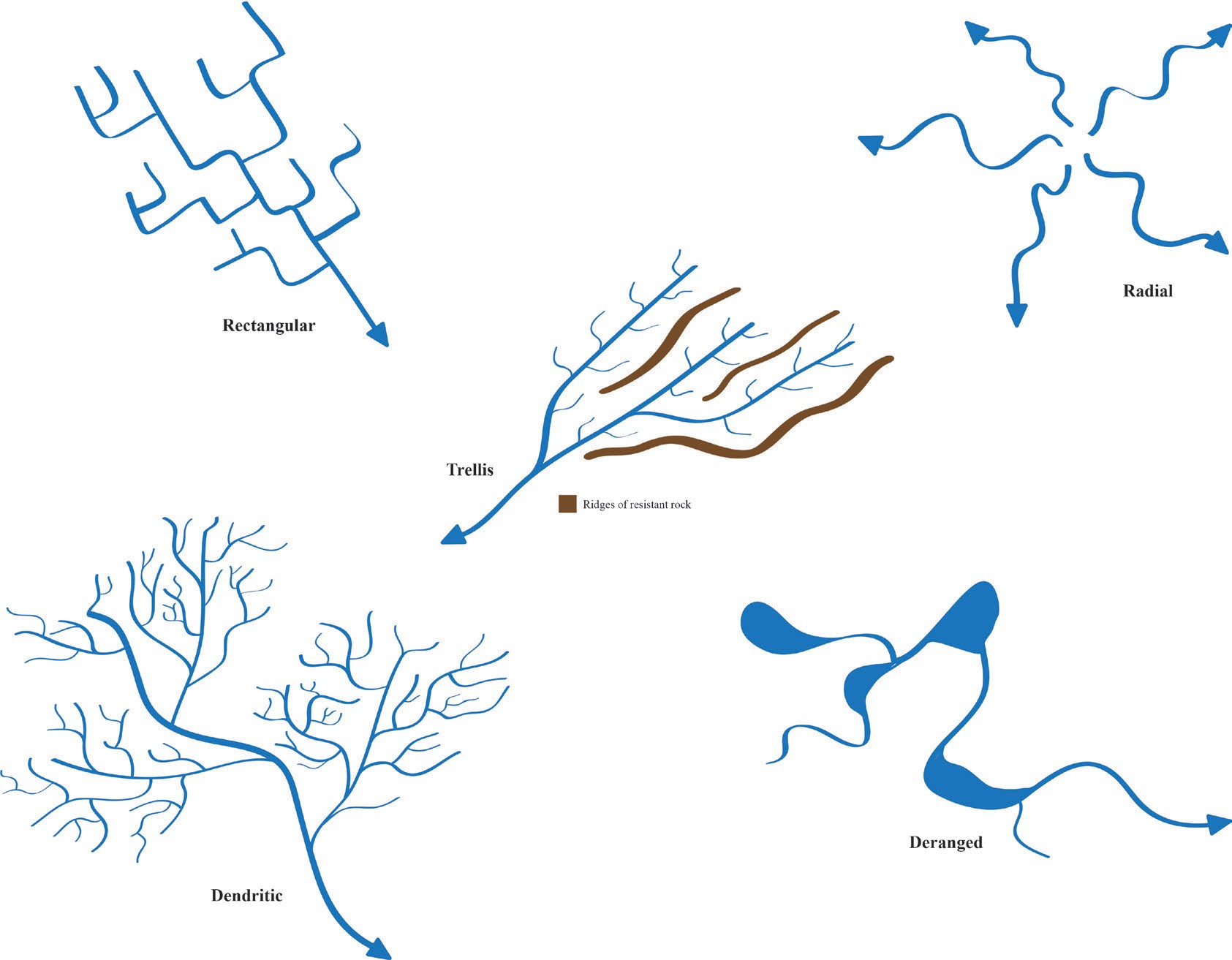
Figure 5.3 | Drainage patterns.
Author: Corey Parson Source: Original Work License: CC BY-SA 3.0
STREAM GRADIENT AND THE CYCLE OF STREAM EROSION
Stream gradient refers to the slope of the stream’s channel, or rise over run. It is the vertical drop of the stream over a horizontal distance. You have dealt with gradient before in Topographic Maps. It can be calculated using the following equation:
Gradient = (change in elevation) / distance
Let’s calculate the gradient from A to B in Figure 5.4 below. The elevation of the stream at A is 980’, and the elevation of the stream at B is 920’. Use the scale bar to calculate the distance from A to B. Gradient = (980’ – 920’) / 2 miles, or 30 feet/mile. Stream gradients tend to be higher in a stream’s headwaters (where it originates), and lower at their mouth, where they discharge into another body of water (such as the ocean). Discharge measures stream flow at a given time and location, and specifically is a measure of the volume of water passing a particular point in a given period of time. It is found by multiplying the area (width multiplied by depth) of the stream channel by the velocity of the water, and is often in units of cubic feet (or meters) per second. Discharge increases downstream in most rivers, as tributaries join the main channel and add water.
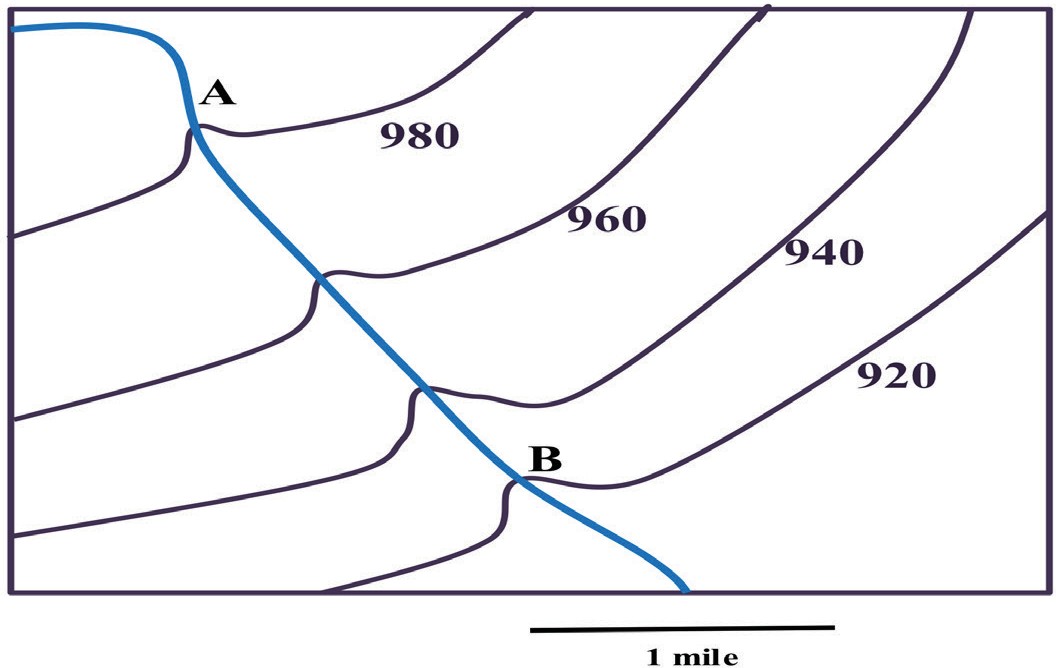
Figure 5.4 | Gradient calculation.
Author: Randa Harris Source: Original Work License: CC BY-SA 3.0
Sediment load (the amount of sediment carried by the stream) also changes from headwaters to mouth. At the headwaters, trib- utaries quickly carry their load downstream, combining with loads from other tributaries. The main river then eventually de- posits that sediment load when it reaches base level. Sometimes in this process of carrying material downstream, the sediment load is large enough that the water is not capable of supporting it, so deposition occurs. If a stream becomes overloaded with sediment, braided streams may develop, with a network of intersecting channels that resembles braided hair. Sand and gravel bars are typi- cal in braided streams, which are common in arid and semiarid regions with high erosion rates. Less commonly seen are straight streams, in which channels remain nearly straight, naturally due to a linear zone of weakness in the underlying rock. Straight channels can also be man-made, in an effort at flood control.
Streams may also be meandering, with broadly looping meanders that resemble “S”-shaped curves. The fastest water traveling in a meandering stream travels from outside bend to outside bend. This greater velocity and turbulence lead to more erosion on the outside bend, forming a featured called a cut bank. Erosion on this bank is offset by deposition on the opposite bank of the stream, where slower moving water allows sediment to settle out. These deposits are called point bars.
As meanders become more complicated, or sinuous, they may cut off a mean- der, discarding the meander to become a crescent-shaped oxbow lake. Check out Figure 5.6 to see the formation of an oxbow lake.

Figure 5.5 | Parts of a meandering stream. The S-curves are meanders. The arrows within the stream depict where the fastest water flows. That water erodes the outside bank, creating a steep bank called the cut bank. The slowest water flows on the inside of the meander, slow enough to deposit sediment and create the point bar.
Author: Randa Harris Source: Original Work License: CC BY-SA 3.0

Figure 5.6 | Formation of an oxbow lake. A meander begins to form and is cut off, forming the oxbow.
Author: User “Maksim” Source: Wikimedia Commons License: CC BY-SA 3.0
Even though streams are not living, they do go through characteristic changes over time as they change the landscape. The ultimate goal of a stream is to reach base level (the low elevation at which the stream can no longer erode its channel– often a lake or other stream; ultimate base level is the ocean). While trying to reach this goal, the stream will experience the cycle of stream erosion, which consists of these stages:
- Youthful (early) stage – these streams are downcutting their channels (vertically eroding); literally they are picking up sediment from the bottom of their channels in an effort to decrease their elevation. The land surface will be above sea level, and these streams form deep V-shaped channels.
- Mature (middle) stage – these streams experience both vertical (downcutting) and lateral (meandering) erosion. The land surface is sloped, and streams begin to form floodplains (the flat land around streams that are subject to flooding).
- Old age (late) stage – these streams focus on lateral erosion and have very complicated meanders and oxbow lakes. The land surface is near base level.
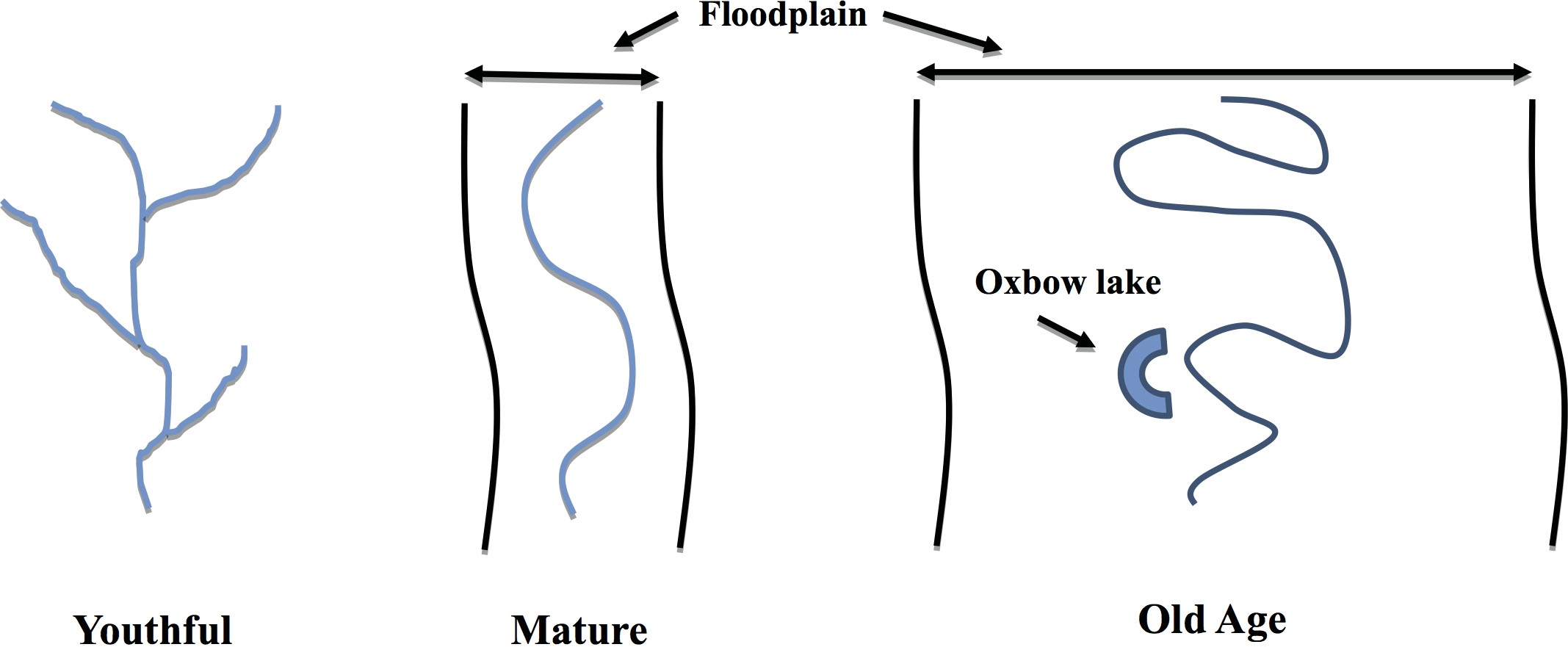
Figure 5.7 | Streams displaying the youthful, mature, and old age stages within the cycle of stream erosion. Note that the youthful stream does not have a floodplain.
Author: Randa Harris Source: Original Work License: CC BY-SA 3.0
An interruption may occur in this cycle. If a stream suddenly begins to down- cut again, if sea level dropped (so base level dropped) or if the area around it was uplifted (think building mountains), then the stream would become rejuvenated. If the rejuvenated stream was in the old age stage, it will begin to form a deep V-shaped channel within that complicated meandering pattern that it has. This creates a neat geologic feature called an entrenched meander (Figure 5.8).
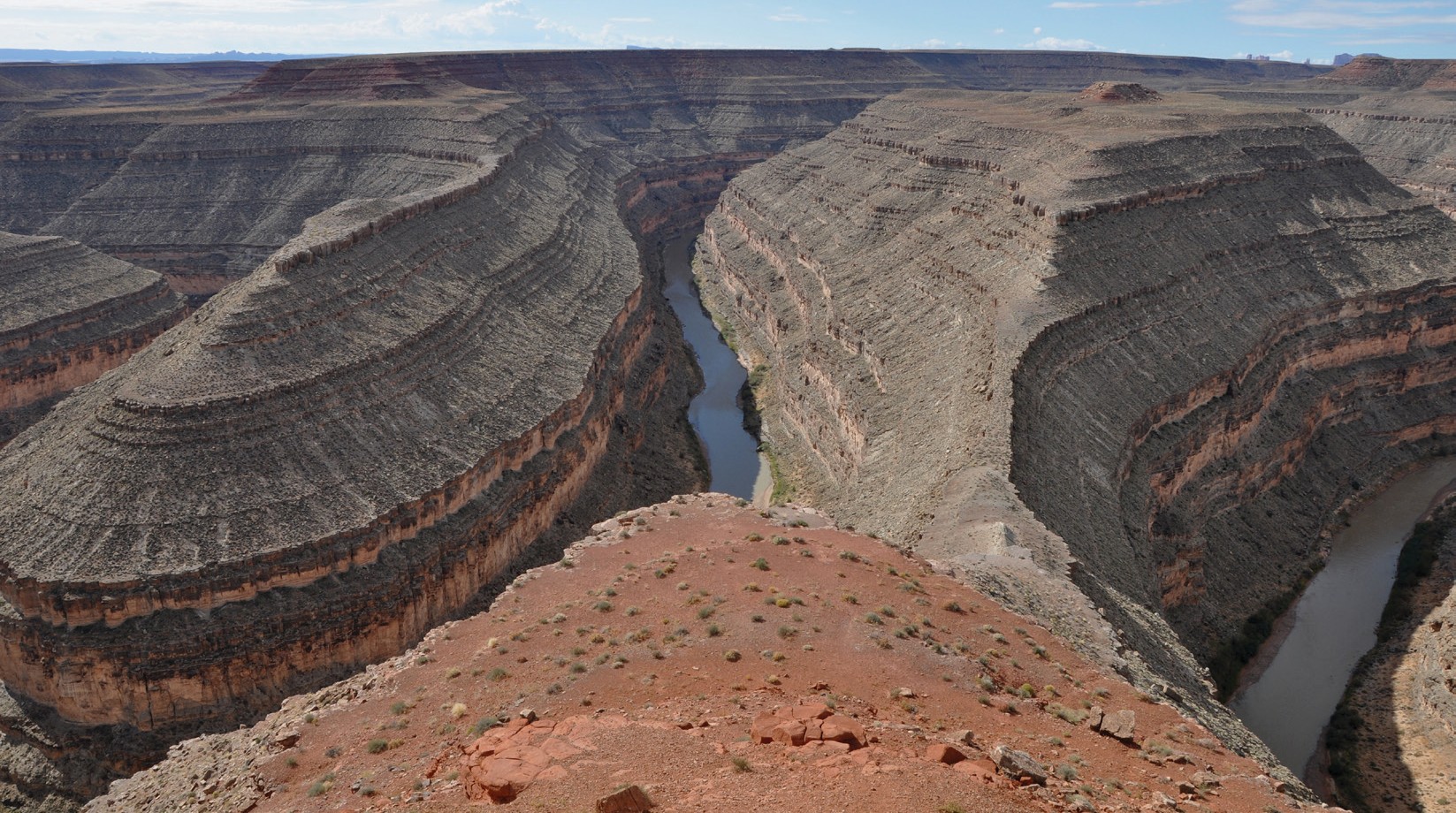
Figure 5.8 | Entrenched meanders along the San Juan River, Goosenecks State Park, Utah.
Author: User “Finetooth” Source: Wikimedia Commons License: CC BY-SA 3.0
FLOODING
Flooding is a common and serious problem in our nation’s waterways. Flood stage is reached when the water level in a stream overflows its banks. Floodplains are popular sites for devel- opment, with nice water views, but are best left for playgrounds, golf courses, and the like. Have you ever heard some- one say that a flood was a 1 in 100 year flood? Does that mean that a flood of similar magnitude will occur every 100 years? No, it only means that, on aver- age, we can expect a flood of this size or greater to occur within a 100 year period. One cannot predict that it will occur in a particular year, only that each year has a 1 in 100 chance of having a flood of that magnitude. It also does not mean that only 1 flood of that size can occur within 100 years.

Figure 5.9 | USGS officials monitoring the flooding of
Sweetwater Creek over I-20 in September, 2009.
Author: USGS Source: USGS License: Public Domain
In order to better understand stream behavior, the U.S. Geological Survey has installed thousands of stream gauges throughout the country, locations with a per- manent water level indicator and recorder. Data from these stations can be used to make flood frequency curves, which are useful in making flood control decisions. In western Georgia, a dramatic flood event occurred in September, 2009 that resulted in 11 fatalities, over $200 million in property damage, and closed Interstate 20 for a day. Rain fell from September 16-22, with a particularly intense period on September 20th. Use information below from a stream gauge located on Sweetwater Creek near Austell, Georgia, to create a flood frequency graph.
5.7 GROUNDWATER
It is best not to envision groundwater as underground lakes and streams (which only occasionally exist in caves), instead think of groundwater slowly seeping from one miniscule pore in the rock to another. Have you ever been to the beach and dug a hole, only to have it fill with water from the base? If so, you had reached the water table, the boundary between the unsaturated and saturated zones. Rocks and soil just beneath the land’s surface are part of the unsaturated zone, and pore spaces in them are filled with air. Once the water table is reached, then rocks and soil pore spaces are filled with water, in the saturated zone.
The water table is said to mimic topography, in that it generally lies near the surface of the ground (often tens of feet below the surface, though this can vary greatly with location). The water table rises with hills and sinks with valleys, often discharging into streams. The water table receives additional inputs as rainfall infiltrates into the ground, called recharge. Its position is dynamic – during droughts the water table will lower and during wet times, it rises.
Two important properties of groundwater that influence its availability and movement are porosity and permeability. Porosity refers to the open or void space within the rock. It is expressed as a percentage of the volume of open space compared to the total rock volume. Porosity will vary with rock type. Many rocks with tight inter- locking crystals (such as igneous and metamorphic rocks) will have low porosity since they lack open space. Sedimentary rocks composed of well sorted sediment tend to have high porosity because of the abundant spaces between the grains that make them up. To imagine this, envision a room filled from floor to ceiling with basketballs (similar to a rock composed completely of sand grains). Now add water to the room. The room will be able to hold a good deal of water, since the basketballs don’t pack tightly due to their shape. That would be an example of high porosity.

Figure 5.10 | The water table is the boundary between the unsaturated zone and saturated zone.
Author: USGS Source: Wikimedia Commons License: Public Domain
Permeability refers to the ability of a geologic material to transport fluids. It depends upon the porosity within the rock, but also on the size of the open space and how interconnected those open spaces are. Even though a material is porous, if the open spaces aren’t connected, water won’t flow through it. Rocks that are permeable make good aquifers, geologic units that are able to yield significant water. Sedimentary rocks such as sandstone and limestone are good aquifers. Rocks that are impermeable make confining layers and prevent the flow of water. Examples of confining layers would be sedimentary rocks like shale (made from tiny clay and silt grains) or un-fractured igneous or metamorphic rock. In an un- confined aquifer, the top of the aquifer is the water table.
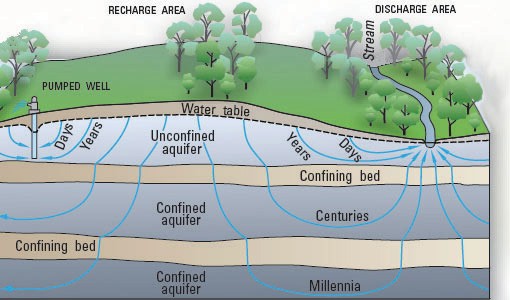
Figure 5.11 | Groundwater flow in both confined and unconfined aquifers.
Author: USGS Source: USGS License: Public Domain
Groundwater generally flows from areas of higher elevation to lower eleva- tion in the shallow subsurface. Note the flow paths in Figure 5.11. Approximately 20% of the water used in the United States is groundwater, and this water has the potential to become contaminated, mostly from sewage, landfills, industry, and agriculture. The movement of groundwater helps spread the pollutants, making containment a challenge.
5.9 KARST TOPOGRAPHY
The sedimentary rock limestone is composed of the mineral calcite, which is water soluble, meaning it will dissolve in water that is weakly acidic. In humid areas where limestone is found, water dissolves away the rock, forming large cavities and depressions which vary in size and shape. As more dissolution occurs, the caves become unstable and collapse, creating sinkholes. These broad, crater-like depressions are typical of karst topography, named after the Karst region in Slovenia. Karst topography is characterized by sinkholes, sink lakes (sinkholes filled with water), caves, and disappearing streams (surface streams that disappear into a sinkhole). Living in karst topography poses its challenges, and approximately one fourth of Americans in the lower 48 states live in these regions. Sinkholes can appear rather rapidly and cause great damage to any structures above them.

Figure 5.13 | Appearance of a sinkhole on a topographic map.
Author: Randa Harris Source: Original Work License: CC BY-SA 3.0


Feedback/Errata